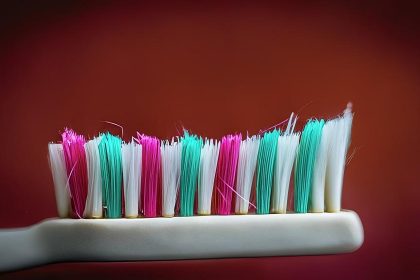Regular toothbrush replacement plays a crucial role in maintaining oral health. While many people keep their toothbrushes until the bristles become visibly frayed, dental professionals recommend replacing them every three months to ensure effective cleaning and prevent bacterial buildup. This practice forms the foundation of proper oral hygiene and helps prevent numerous dental issues.
Why quarterly replacement matters
Your toothbrush serves as the primary tool for dental hygiene, but its effectiveness diminishes over time. Worn bristles lose their ability to clean properly, while bacterial accumulation can compromise oral health. Fresh bristles maintain their shape and cleaning power, effectively removing plaque and debris from teeth and gums.
The importance of regular replacement extends beyond basic cleaning. Your toothbrush can harbor bacteria, fungi, and even mold over time. These microorganisms multiply in the moist environment of your bathroom, potentially leading to oral infections and other health issues. Quarterly replacement helps maintain a hygienic tool for your daily oral care routine.
Risks of prolonged toothbrush use
Using a toothbrush beyond its recommended lifespan poses several health risks. Worn bristles cannot effectively remove plaque from teeth and gums, potentially leading to cavities and gingivitis. The reduced cleaning efficiency may result in tartar buildup, requiring professional dental intervention.
Extended use of old toothbrushes can also lead to:
- Increased risk of gum inflammation and bleeding
- Persistent bad breath due to bacterial buildup
- Higher likelihood of tooth decay from inadequate cleaning
- Transfer of illness-causing bacteria back into your system
- Potential damage to tooth enamel from frayed bristles
Recognizing replacement signals
While three months serves as a general guideline, certain signs indicate the need for immediate replacement:
Frayed or bent bristles signal decreased cleaning effectiveness. When bristles lose their original shape, they cannot properly clean between teeth and along the gum line. Splayed bristles often indicate aggressive brushing or extended use beyond the recommended period.
Discoloration of bristles often indicates bacterial growth. Many modern toothbrushes include color-changing indicators that fade when replacement time approaches. These indicators provide a visual reminder to maintain proper replacement schedules.
After illness, replace your toothbrush immediately to prevent reinfection. Cold and flu viruses can survive on toothbrush bristles, potentially prolonging illness or spreading it to family members who accidentally use the wrong toothbrush.
Proper toothbrush maintenance
Between replacements, proper care extends your toothbrush’s effectiveness:
Daily care practices should include thorough rinsing after each use to remove debris and toothpaste residue. Store the brush upright in an open-air environment to promote drying and prevent bacterial growth. This position allows water to drain and air to circulate around the bristles.
Avoid storing toothbrushes in closed containers for extended periods, as moisture promotes microbial growth. Keep toothbrushes separated to prevent cross-contamination between family members. When traveling, use a ventilated cover to protect bristles while allowing airflow.
Selecting the right replacement
When choosing a new toothbrush, consider these essential factors:
Bristle softness affects cleaning effectiveness and gum health. Soft bristles clean effectively while protecting enamel and gum tissue from damage. Medium and hard bristles may seem like they clean better, but they can actually harm your teeth and gums.
Head size should allow easy access to all areas of your mouth. Smaller heads often provide better maneuverability around back teeth and hard-to-reach areas. A comfortable size enables thorough cleaning of all tooth surfaces.
Handle design impacts brushing effectiveness. Choose an ergonomic design that provides comfortable control during use. The right grip can help maintain proper brushing technique and prevent hand fatigue.
Benefits of regular replacement
Maintaining a regular replacement schedule offers significant advantages for your oral health:
Fresh bristles remove plaque more effectively, reducing cavity risk. New toothbrushes clean more thoroughly between teeth and along the gum line, helping prevent tooth decay and gum disease.
Clean bristles minimize bacterial exposure during brushing. Regular replacement reduces the risk of reintroducing harmful bacteria into your mouth. This practice supports overall oral hygiene and helps maintain fresh breath.
Proper cleaning technique becomes more effective with maintained tools. Well-functioning bristles support proper brushing mechanics and ensure optimal plaque removal during your daily routine.
Creating a replacement routine
Establish a consistent replacement schedule using these proven strategies:
Mark calendar dates at three-month intervals for easy tracking. Many people find it helpful to change toothbrushes at the start of each season, creating a natural reminder system.
Keep spare toothbrushes available to ensure immediate replacement when needed. Consider subscription services that deliver new toothbrushes quarterly, eliminating the need to remember purchases.
Professional recommendations
Dentists emphasize that toothbrush replacement represents one component of comprehensive oral care. Regular dental checkups, proper brushing technique, and daily flossing complement this habit. A complete oral hygiene routine, including timely toothbrush replacement, helps prevent cavities, gum disease, and other dental problems.
Remember that individual circumstances might require more frequent replacement. Consult your dentist about specific recommendations based on your oral health needs, brushing habits, and any existing dental conditions.
Regular toothbrush replacement, while simple, significantly impacts oral health. This quarterly habit, combined with proper dental care, helps maintain a healthy smile and prevents various oral health issues. Start implementing this important practice today to protect your oral health for years to come.
This story was created using AI technology.









